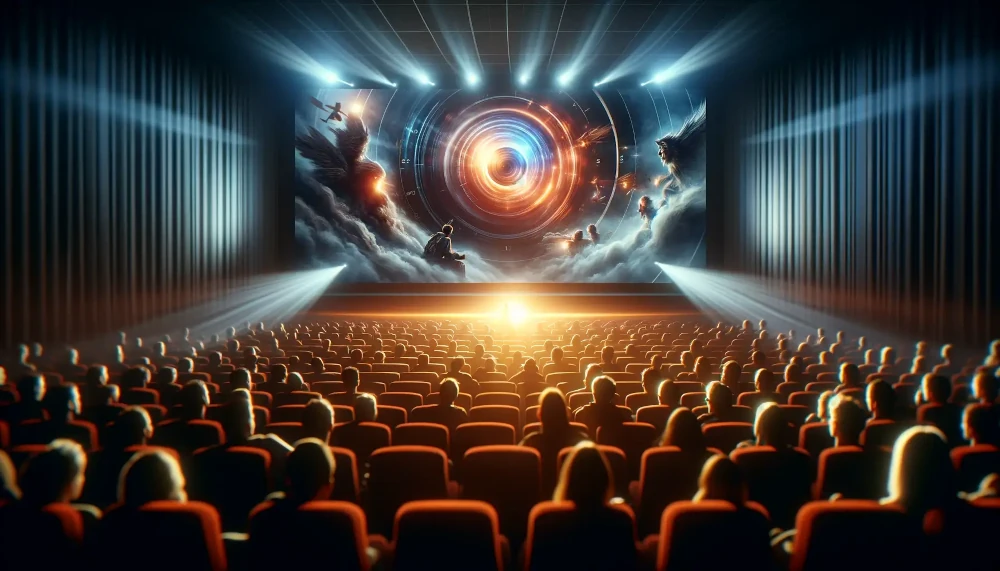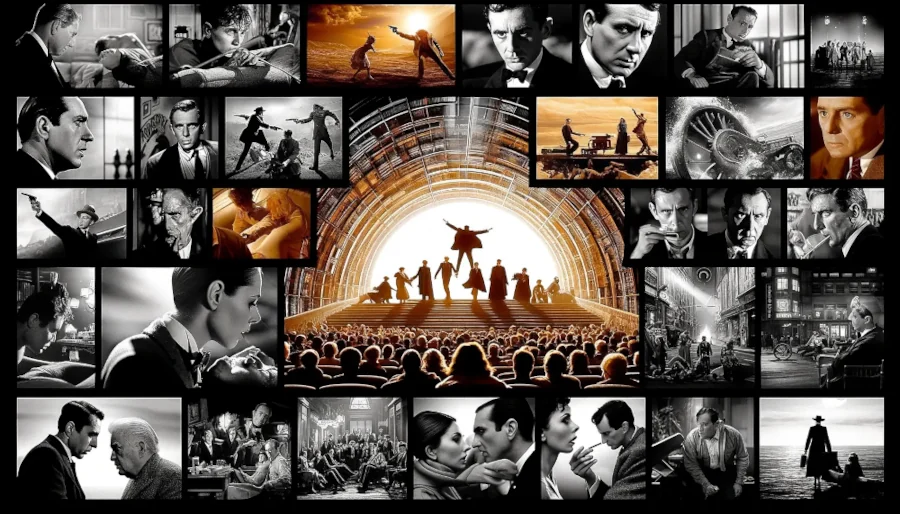In the captivating world of filmmaking, every camera movement holds the potential to tell a story, evoke emotions, and create an unforgettable visual experience. Among these cinematic tools, the arc shot stands out as a dynamic and visually striking technique. This article delves into the world of arc shots, unraveling their definition, significance, and the unique storytelling power they possess in the film industry.
Key Takeaways
- Arc shots require careful equipment selection, including dollies, cranes, and drones.
- Stabilization is key for smooth camera movement.
- Precise planning, choreography, and lighting are essential.
- Post-production enhances the shot’s fluidity and integration into the film.
- Arc shots in film storytelling add emotional depth and dynamic engagement.
Defining Arc Shot
An arc shot is a cinematic technique in which the camera moves around the subject in a curved trajectory, typically encompassing a 180 to 360-degree motion.
What is an Arc Shot in Films
In filmmaking, an arc shot is a camera technique where the camera moves in a circular path around the subject. This creates a dynamic, rotating view of the scene, often used to add dramatic effect, emphasize emotions, or showcase the environment surrounding the subject. Arc shots are notable for their ability to engage viewers, offering a more immersive and comprehensive perspective in a film’s visual storytelling.
History and Evolution of Arc Shots
The early use of arc shots can be traced back to the silent film era of the early 20th century. Initially, filmmakers used basic track systems to move the camera around the subject. These rudimentary techniques were revolutionary for their time, allowing directors to experiment with more dynamic storytelling methods than the static shots that were common in early cinema.

Modern-Day Filmmaking
In modern cinema, arc shots have benefited from digital technology and advanced equipment like Steadicams and drones. These tools have allowed for even more creative and ambitious shots, seamlessly integrating with visual effects to create scenes that were previously impossible.
Importance of Arc Shots in Film
Arc shots hold significant importance in film due to their ability to enhance storytelling and emotional impact. Arc shots offer a unique perspective by highlighting character emotions and setting the tone of a scene. The strategic use of arc shots contributes to the visual language of a film, often turning ordinary scenes into memorable cinematic moments.
Discover more about POV shots in Screenplay
Technical Aspects of Shooting an Arc Shot
Arc shots combine intricate details and equipment for dynamic movement.
- Choosing the Right Equipment: Essential for achieving desired movement and perspective.
- Stabilizing the Camera: Ensures fluid motion and professional quality.
- Planning and Choreography: Coordination between camera and scene elements is crucial.
- Lighting Considerations: Must be consistent and mood-enhancing.
- Post-Production Enhancements: Refines and integrates the shot into the film’s visual narrative.
Learn More: What is Post-Production in Filmmaking
Examples of Arc Shots in Cinema
Some of the most iconic examples of arc shots and their impact on film storytelling.

Classic Cinema: In classic cinema, arc shots were used to enhance dramatic tension or highlight pivotal moments in a story. Films like Alfred Hitchcock’s “Vertigo” employed arc shots to create a sense of disorientation and suspense, aligning perfectly with the film’s psychological themes.
Musicals and Epics: Musicals and epic films often used arc shots to showcase elaborate set designs, dance numbers, and large casts. These shots added a sense of grandeur and spectacle, immersing the audience in the film’s visual extravagance.
Modern Blockbusters: In contemporary cinema, directors like Christopher Nolan and Quentin Tarantino have utilized arc shots to add dynamic energy and a unique visual style to their films. These shots are often used in action sequences or to convey a character’s emotional journey.
International Cinema: Arc shots have also been a staple in international cinema, with directors from various countries incorporating them to tell culturally nuanced stories. These shots have helped to bridge storytelling styles across different film industries, showcasing the universal language of cinema.
Examples of Iconic Arc Shots in Movies
Numerous films have effectively utilized arc shots to enhance their storytelling. Here are some notable examples:
1. Vertigo (1958)
Alfred Hitchcock’s “Vertigo” is a classic example of the arc shot’s psychological impact. The film features a memorable arc shot that circles around the character Scottie, played by James Stewart, as he grapples with his fear of heights and obsession with a woman. This shot not only emphasizes Scottie’s emotional turmoil but also creates a sense of disorientation, mirroring the film’s themes of obsession and identity.
2. A Beautiful Mind (2001)
In “A Beautiful Mind,” directed by Ron Howard, an arc shot is used to depict the protagonist, John Nash, played by Russell Crowe, as he navigates his complex mental landscape. The camera moves around Nash during a pivotal moment, capturing his internal struggle and the chaos of his thoughts. This technique effectively immerses the audience in Nash’s experience, making his journey more relatable and poignant.
3. Pulp Fiction (1994)
Quentin Tarantino’s “Pulp Fiction” features several arc shots that contribute to the film’s unique style. One notable instance occurs during the iconic dance scene between Vincent and Mia, played by John Travolta and Uma Thurman. The camera moves in an arc around the couple, enhancing the energy of the moment and showcasing their chemistry. This shot not only adds visual flair but also reinforces the film’s playful tone.
4. The Dark Knight (2008)
Christopher Nolan’s “The Dark Knight” employs arc shots to heighten tension during action sequences. A notable example occurs during the bank heist scene, where the camera circles around the robbers and the Joker, played by Heath Ledger. This movement creates a sense of chaos and urgency, immersing the audience in the unfolding drama and emphasizing the Joker’s unpredictable nature.
5. Django Unchained (2012)
In “Django Unchained,” Tarantino again utilizes arc shots to enhance storytelling. During a crucial scene where Django confronts his former owner, the camera arcs around the characters, capturing their emotions and the weight of the moment. This technique effectively conveys the tension and stakes involved, making the scene more impactful for viewers.
Use of Different Arc Shots
- Classic Cinema: Used for suspense and disorientation.
- Musicals and Epics: Adds grandeur to set designs and dance numbers.
- Modern Blockbusters: Brings dynamic energy and unique visual style.
- International Cinema: Bridges storytelling styles globally.
Impact of Arc Shots on Storytelling
Arc shots significantly influence viewer engagement and narrative depth.
- Enhancing Emotional Connection: Creates intimacy and involvement with characters.
- Symbolism and Meaning: Adds layers of meaning through direction and speed.
- Creating a Dynamic Viewing Experience: Engages and leaves a lasting impression on viewers.
Closing Thoughts
Arc shots in filmmaking are more than technical achievements; they are powerful storytelling tools that enhance emotional connection, symbolize deeper meanings, and create a dynamic viewing experience.
Check out 5 best video production management software
About RFM
RFM is a web-based video, TV, and film production management software that offers various features for professionals in the entertainment industry. It allows users to write professional project briefs and descriptions, talent, and actor showcases, visualize scenes with shot lists, media sharing and manage various aspects of production, including call sheets, shooting schedules, and script breakdowns. RFM is designed to help teams collaborate more effectively during the production process, making it a valuable tool for filmmakers, photographers, and video production companies
Read more of our articles here: Is Digital Marketing Legit? A Comprehensive Guide